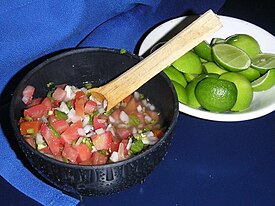Pico de gallo: Difference between revisions
Undid revision 902558864 by 199.247.47.190 (talk) The Tollefsrud bit is unsourced & has been flagged for a while. Maybe take this to the Talk page? |
Lukeferg96 (talk | contribs) Fixed literal translation word for word translation Tags: Mobile edit Mobile web edit |
||
| Line 5: | Line 5: | ||
[[File:Mexico.Salsa.01.jpg|thumb|275px|Pico de gallo]] |
[[File:Mexico.Salsa.01.jpg|thumb|275px|Pico de gallo]] |
||
In [[Mexican cuisine]], '''''pico de gallo''''' ({{IPA-es|ˈpiko ðe ˈɣaʎo}}, {{literal translation| |
In [[Mexican cuisine]], '''''pico de gallo''''' ({{IPA-es|ˈpiko ðe ˈɣaʎo}}, {{literal translation|Peak of rooster}}), also called '''''salsa fresca''''' or '''''salsa cruda''''', is traditionally made from chopped [[tomato]], [[onion]], and [[coriander|cilantro]], with lime juice mixed in. |
||
''Pico de gallo'' can be used in much the same way as other Mexican liquid [[Salsa (sauce)|salsas]], but since it contains less liquid, it can also be used as a main ingredient in dishes such as [[taco]]s and [[fajita]]s. |
''Pico de gallo'' can be used in much the same way as other Mexican liquid [[Salsa (sauce)|salsas]], but since it contains less liquid, it can also be used as a main ingredient in dishes such as [[taco]]s and [[fajita]]s. |
||
Revision as of 15:57, 7 July 2019
This article needs additional citations for verification. (March 2017) |

In Mexican cuisine, pico de gallo (Spanish pronunciation: [ˈpiko ðe ˈɣaʎo], lit. 'Peak of rooster'), also called salsa fresca or salsa cruda, is traditionally made from chopped tomato, onion, and cilantro, with lime juice mixed in.
Pico de gallo can be used in much the same way as other Mexican liquid salsas, but since it contains less liquid, it can also be used as a main ingredient in dishes such as tacos and fajitas.
The tomato-based variety is widely known as salsa picada (minced/chopped sauce). In Mexico it is normally called salsa mexicana (Mexican sauce). Because the colours of the red tomato, white onion, green chili and cilantro are reminiscent of the colours of the Mexican flag, it is also sometimes called salsa bandera (flag sauce).
In many regions of Mexico the term refers to any of a variety of salads (including fruit salads), salsa, or fillings made with tomato, tomatillo, avocado, orange, jícama, cucumber, papaya, or mild chilis. The ingredients are tossed in lime juice and optionally with either hot sauce or chamoy, then sprinkled with a salty chili powder.
Etymology
According to food writer Sharon Tyler Herbst,[1] pico de gallo ("rooster's beak") is named thus because originally people ate it by pinching pieces between the thumb and forefinger.
In their book Authentic Mexican: Regional Cooking from the Heart of Mexico, Rick Bayless and Deann Groen speculate that the name might allude to the bird feed-like texture and appearance of the mince.[2]
Many native residents of the Sonoran Mexico region explain that the salsa is thus named because the serrano pepper resembles a rooster's beak in shape.[3]
See also
- Salad
- Pebre, a similar condiment from Chile
- List of Mexican dishes
- List of tomato dishes
 food portal
food portal
References
- ^ Sharon Tyler Herbst, "Food Lover's Companion", 2nd ed., as quoted in Barron's Educational Services, Inc. 1995: www.Epicurious.com, retrieved 10/3/2007 [1]
- ^ Bayless, Rick; Groen, Deann. Authentic Mexican: Regional Cooking from the Heart of Mexico.
- ^ Wilder, Janos. The Great Chiles Rellenos Book. Ten Speed Press, 2013.
External links
 Pico de Gallo at the Wikibooks Cookbook subproject
Pico de Gallo at the Wikibooks Cookbook subproject













